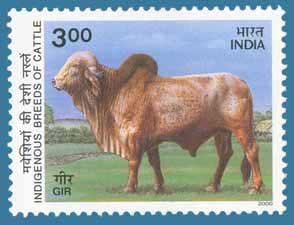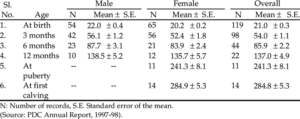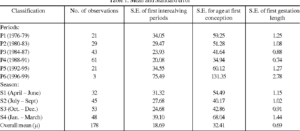GIR – CATTLE BREED (BULL/COW)
Gir Cattle – Breeding status: Conservation
Country: India
Home or breeding tract: Gir breed (cow/ bull) belongs to Gir Hills and forest of Kathiawar including Amreli, Bhavnagar, Junagadh, and Rajkot districts of Gujarat.
Other Names: Bhodali, Desan, Gujarati, Gyr, Kathiawari, Sorthi and Surti.

Gir Cow breed is one of the best milkers among the other native breed from India, This breed is named after the Gir Forest geographical origin area of this breed.
Body: Gir bull is More massive and of larger built.
Body colour: These cattle are shiny red with white spots.
Skin: Gir cow’s skin is soft, thin and glossy
Head/Forehead: They have a big head with a prominent bulging shield and a long face. The convex forehead of Gir cattle is the most unusual feature of this breed. Their convex forehead acts as a cooling radiator to the brain and pituitary gland.
Ears: Gir Cow ears are very long and are an excellent fly and insect swatter
Neck: Dark
Dewlap: Big and Thick
Shoulder hump: They have a very large hump
Penis sheath flap: Thick
Horns: The horns of Gir cattle are set well back on their heads and thick at the base. Their horns grow downwards and backwards with an upward curve.
Production traits: Gir Cow is one of the best milkers, not as like most of the Indigenous cattle breeds.
Ability as a draught purpose: They are fast trotters but suitable for the heavy draught.
Exhibition of the world’s best Top 10 Gir Cow’s
Need Support:
We are currently searching for additional photographs and information on this breed. If you have materials which we could borrow or if you know of a potential source please contact us using the comment form below.
The Gir cattle breed of India – characteristics and present status
G.K. Gaur, S.N. Kaushik & R.C. Garg
Summary
The Gir is a famous milk cattle breed of India. The native tract of the breed is Gir hills and forests of Kathiawar including Junagadh, Bhavnagar, Rajkot and Amreli districts of Gujarat. The breeding tract lies between 20°5’ and 22°6’ north latitude and 70° and 72° east longitude. The total cattle population of Saurashtra region i.e., the breeding tract of Gir cattle is 2.5 million and Gir breed accounts for 37 per cent of total cattle population in the region. The body of Gir animals is well proportioned. The udder in cows is well developed and round. The body weight at one year of age was 138 kg in males and 136 kg in females. Adult body weight, height at withers, body length and heart girth in cows averaged 313 kg, 120 cm, 125 cm and 160 cm, respectively.
Age at first heat and calving averaged 1 149 and 1 534 days, respectively. Average dry period and inter-calving period were 123 and 423 days, respectively. Heifers received an average of 1.07 inseminations for successful conception whereas cows received 1.64 inseminations per conception. Total lactation milk yield averaged 2 063 litres in an average lactation period of 326 days. Average milk yield in 300 days was 1 930 litres. Milk yield per day of calving interval was 4.98 litres. Average fat percentage in the milk ranged between 4.69±0.04 and 4.97±0.02. Gir animals are considered as hardy with low overall mortality (3.63 per cent).
Introduction
The Gir is a famous milk cattle breed of India. The native tract of the breed is Gir hills and forests of Kathiawar including Junagadh, Bhavnagar, Rajkot and Amreli districts of Gujarat. This breed is also known as Bhodali, Desan, Gujarati, Kathiawari, Sorthi and Surti in different parts of the breeding tract. The Gir animals are famous for their tolerance to stress conditions and resistance to various tropical diseases. Bullocks of this breed are used to drag heavy loads on all kinds of soil. Brazil, Mexico, USA and Venezuela have imported these animals where they are being bred successfully. These animals contribute significantly to the total milk production of Gujarat State. This paper presents information on breed characteristics, demographic distribution, morphological characteristics, management practices and reproduction and production parameters of Gir cattle.
Topography and Climate
The breed derives its name from the Gir forest, which is the natural habitat of the breed. The breeding tract lies between 20°5’ and 22°6’ north latitude and 70° and 72° east latitude (Figure 1). The track is at an altitude of about 400 m above mean sea level ranging from 125 to 600 m. Soil is generally black with scattered tracts of light colours. The climate of the region is tropical. The temperature reaches 40°C (highest) in May and 11°C (lowest) in January. Rainfall ranges from 50 to 100 cm annually. The climate is dry in winter. The relative humidity ranges from 60 to 80 per cent during the rainy season (July to September).
Management Practices
The Rabaris, Bharwads, Maldharis, Ahirs and Charans tribes are mainly involved in the rearing of Gir cattle. They move with their cattle from one place to another in search for grazing. Sufficient fodder is available in pastures of the breeding tract from July to December, thereafter animals migrate to the adjoining districts. Weaning of the calves (Figures 2 and 3) has not been practised and milking cows, newborn calves and bullocks are not sent for grazing in villages. Milking cows and bullocks (Figure 4) are given some amount of concentrate (1 to 3 kg/day), which is prepared from wheat bran, crushed pulses, grain husk, oil cakes, cottonseed, etc. Proper shelter is provided to the animals especially in winter nights. The animals in migration stay in fallow land during the night. Nominal payment (by farmers) is made to the animal owners for their animals to stay in the fields as dung and urine are very precious for the soil fertility. The Gir animals are also kept at different gaushalas (cow barns) in Gujarat State. These animals are maintained on green fodder, concentrates and pasture. Natural mating is practised in the entire breeding tract except on a few farms where artificial insemination takes place. The calving season in Gir cows lasts from July to September.

Population
The total cattle population of the Gujarat State is 6.24 million, which is about 3.13 per cent of India’s cattle repository (Dairy India, 1997). The herd size (Figure 5) varies from a few animals (two to five) to relatively larger herds (10 to 20). The size of the migratory herds ranges from 100 to 200. The population of breedable females in the state is 1.78 million including 0.084 million in Amreli, 0.117 million in Bhavnagar, 0.142 million in Rajkot and 0.140 million in Junagadh districts. The total cattle population of Saurashtra region i.e. breeding tract of Gir cattle is 2.5 million and Gir breed accounts for 36.61 per cent of total cattle population in the region (Anonymous, 2001).
Physical Characteristics
The coat colour of Gir animals varies from shades of red and white to almost black and white or entire red. Skin colour is dominantly black but in a few animals, it is brown. The forehead is prominent, convex and broad like a bony shield. This overhangs eyes in such a way that they appear to be partially closed and the animal shows sloppy appearance. Ears are long and pendulous and folded like a leaf with a notch at the tip. Horns are curved turning back at the tip. They orient downwards and backwards from the base and incline a little upwards and forwards, thereafter. Gir animals have moderately developed dewlap: males have a large and pendulous sheath. The tail is long and whip-like; hooves are black and medium-sized; hair is short and glossy; skin is loose and pliable; hipbones are prominent; the body is well proportioned; the udder in cows is well developed and round and teat tips are round.
Table 1. Bodyweight (kg) at different ages in Gir cattle.

Morphometric Characteristics
Body weights of Gir cattle at different ages are shown in Table 1. Males were heavier than the females at all ages from birth to 12 months of age. Bodyweight at one year of age was 138 kg in males and 136 kg in females. Kaushik et al. (1980), however, reported lower body weight at birth in Gir cattle. Tripathi et al. (1978), based on 326 Gir cows (Figures 6 and 7), reported average adult body weight as 313.05 kg, average height at withers as 120.4 cm, average body length as 125.14 cm and average heart girth as 160.53 cm. In a study on 72 Gir cows, Qureshi et al. (1980) observed mean udder length, udder width and udder depth as 53.80±0.40, 50.11±0.40 and 13.61±0.39 cm, respectively. In a herd of 240 cows, Tripathi et al. (1982) reported frequency of bowl-shaped, rounded and goat-like udders as 59.6, 39.5 and 0.90 per cent, respectively. The frequency of cylindrical, funnel-shaped and bottle-shaped teats was 31.5, 15.4 and 3.1 per cent for fore teats and 27.5, 21.2 and 1.4 per cent for rear teats, respectively. Teat length, diameter and placement averaged 7.28, 2.88 and 3.11 cm, respectively. The distances between front teats and between rear teats averaged 5.57±0.22 and 2.09±0.12 cm, respectively.
Reproductive Performance
Reproductive performance of Gir heifers and cows is presented in Table 2. Heifers received a lesser number of artificial inseminations for successful conception than cows. Service period and calving interval presented in the table are lower than those reported by Ulmek and Patel (1995). Their values were 174.5 days for service period and 461.5 days for calving interval. Singh et al. (1981) observed age at first calving in Gir cows as 52.49 months. Age at first oestrus, gestation length, age at calving, service period, dry period and calving interval in 57 Gir heifers averaged 1 096, 287, 1 367, 317, 271 and 603 days, respectively (Malik and Ghei, 1977).
Production Performance
Production performance in Gir cows is presented in Table 3. Two cows (Lalita and Laxmi) produced more than 2 800 litres of milk in lactation of 300 days. Nanavati and Qureshi (1996) observed 10±0.10 kg average peak yield and 47±0.83 days to attain a peak in 211 Gir cows. Ulmek and Patel (1993a) reported average lactation and 300 days milk yield in 378 Gir cows as 1 775 and 1 449 kg, respectively. They also observed that milk yield was significantly affected by parity and season of calving. Ulmek and Patel (1993b) reported milk yield per day of age at first calving, per day of first calving interval and per day of first lactation length as 1.10±0.04, 4.20±0.14 and 5.54±0.12 kg, respectively. Malik and Ghei (1977) in a study on 57 Gir Hiefers observed 351 days lactation length and 1 191 kg lactation milk yield. Average fat percentage in the milk of Gir cows ranged between 4.69±0.04 and 4.97±0.02.
Table 2. Reproductive performance of Gir cows.


Table 3. Production performance of Gir cows.

Disease Pattern/Survivability
Gir animals are considered as hardy with low overall mortality. Mortality pattern is presented in Table 4. The highest mortality was observed from birth to one month of age. Female calves had higher mortality than males during this stage. Mortality was very marginal after one year of age. Odedra (1979) has also reported similar calf mortality in Gir animals. Broncho-Pneumonia and Pneumo-Enteritis were the major causes of mortality in calves. A few cases of reproductive disorders i.e. dystokia, abortion, retention of placenta, prolaps have also been noticed in females.
Table 4. Mortality pattern in Gir herd.

Conservation and Genetic Improvement Programmes
This breed has been crossed with exotic breeds in All India Coordinated Research Project (Cattle) for the genetic improvement. The major objective of this mega project was to develop a crossbred strain suitable for the existing environmental conditions. The Animal Husbandry Department initiated a genetic improvement programme for Gir animals. Young Gir bulls are being progeny tested under this programme.
The Indian Council of Agricultural Research (ICAR) started two projects on Gir cattle, one is executed by the National Bureau of Animal Genetic Resources (NBAGR) for the conservation of breed and another by the Project Directorate on Cattle (PDC) for genetic improvement. The objectives of the former project are to characterise the breed in terms of qualitative and quantitative traits, to study the molecular genetic characteristics of the breed, develop breed descriptors and conserve the germplasm of elite/unique animals. The latter project aims to undertake testing and selection of bulls for the genetic improvement and to provide superior germplasm for utilisation in other development programmes.
Article source: www.fao.org
..
Read More: Other Native cattle
For More information and purchase on different indigenous breeds
Alambadi Cattle | Amrit Mahal Cattle | Bachaur cattle | Bargur Cattle | Gir Breed |Kasaragod Dwarf Cattle | Kherigarh Cattle | Krishna Valley cattle | Malnad Gidda Cattle | Mewati Breed | Ongole breed cattle | Ponwar Breed | Pulikulam Cattle | Umblachery Cattle | Vechur Cattle Breed
..
Read More: Native Dog breed
For More information on Indian native dog breeds.
Banjara Greyhound | Bully kutta mastiff | Chippiparai Hound | Gaddi Kutta mastiff | Indian Spitz | Jonangi breed | Kanni hound dog | Kombai/Combai hound dog | Mudhol Hound | Pandikona Hound | Rajapalayam Hound | Rampur Hound
..
Also Read : Other Blog
How to Recognise Native British Cattle Breeds | The American Bison | Recognized indigenous cattle breeds of India | List of Bos Indicus Breeds – Zebu Breed | First Domesticated Cattle in the World : Origin of Modern Cows Traced | 40 million cows to get Aadhaar like number at cost of Rs 50 crore in 1st phase : Budget 2018 | Registration of livestock/poultry breeds rises to 169: Govt | Chennai to host expo of indigenous native cattle breeds on Jan 6 and 7. | Kerala Sets up a special reproduction centre to help grow Vechur cattle population | Andhra pradesh well poised to become a seed hub, says Bill Gates | Using Cow Dung of Indigenous Breeds, This Farmer Makes Lakhs from Organic Papaya | Kampala to host 2017 livestock show | Cargill to plough millions into animal nutrition business in India | Supreme Court issues notice to Tamil Nadu government on PETA plea against jallikattu | Haryana govt plans PGs for cattle to boost milk production | Molecular Characterisation of Rathi and Tharparkar Indigenous Cattle (Bos indicus) | Embryo transfer technology to be used to carry out 440 embryo transfers in cattle in 9 days | ‘Rettamalai Ondikaruppu’ Temple Bull , is no more | Decline in indigenous cow breeds: NGT summons official | Maharashtra moos to boost desi/Indigenous cow varieties | Soon desi cow’s milk will be sold through medical stores: Warns Rajasthan minister | Telangana ties up with Brazil to improve Desi milk production | Project Mooo: supporting India’s dairy farmers with sustainable technology | Government allocates ₹2.5 cr. for protection of native cattle breeds | Project to preserve indigenous cattle – Karnataka.| Alanganallur was the most crowded village today in India! | Tamils Gathered in America, To show Support Jallikattu!! |